instrument panel KIA Opirus 2007 1.G Owner's Manual
[x] Cancel search | Manufacturer: KIA, Model Year: 2007, Model line: Opirus, Model: KIA Opirus 2007 1.GPages: 283, PDF Size: 18.42 MB
Page 7 of 283
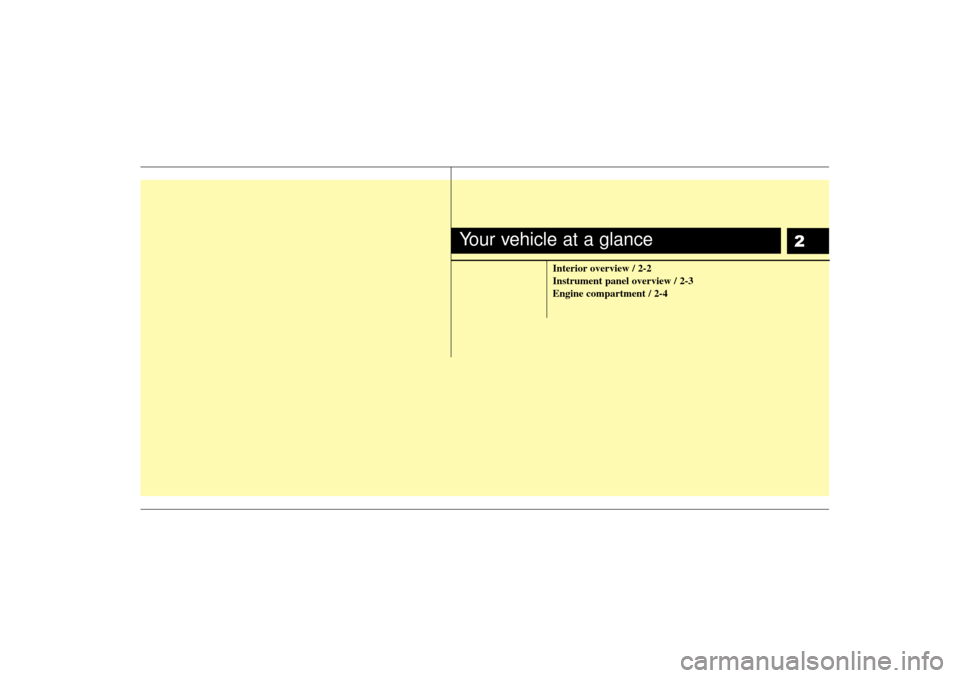
2
Interior overview / 2-2
Instrument panel overview / 2-3
Engine compartment / 2-4
Your vehicle at a glance
Page 8 of 283
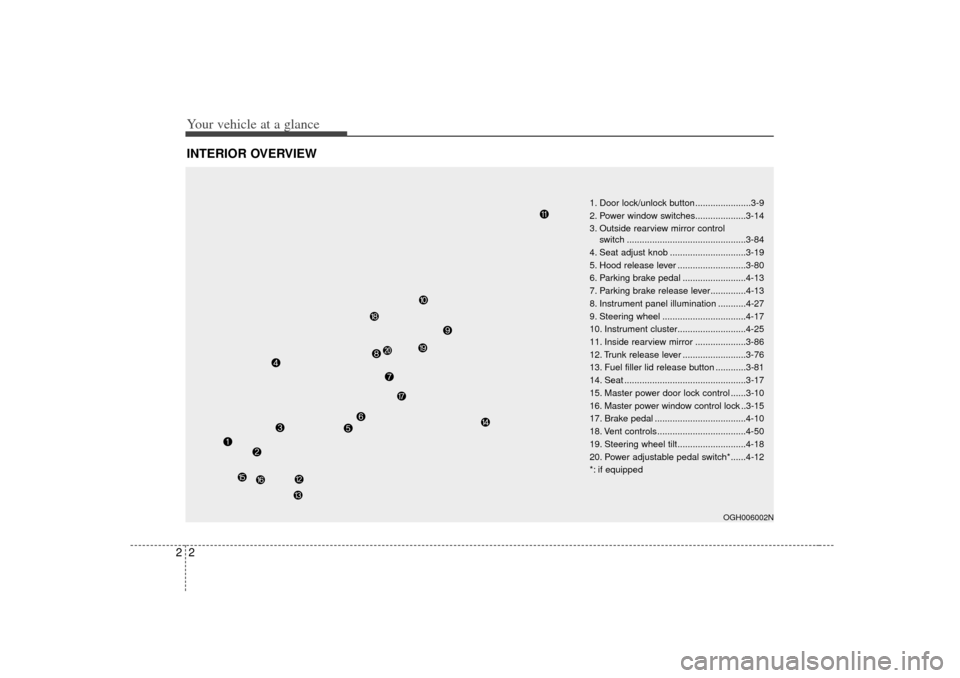
Your vehicle at a glance22INTERIOR OVERVIEW
OGH006002N
1. Door lock/unlock button ......................3-9
2. Power window switches....................3-14
3. Outside rearview mirror control switch ...............................................3-84
4. Seat adjust knob ..............................3-19
5. Hood release lever ...........................3-80
6. Parking brake pedal .........................4-13
7. Parking brake release lever..............4-13
8. Instrument panel illumination ...........4-27
9. Steering wheel .................................4-17
10. Instrument cluster...........................4-25
11. Inside rearview mirror ....................3-86
12. Trunk release lever .........................3-76
13. Fuel filler lid release button ............3-81
14. Seat ................................................3-17
15. Master power door lock control ......3-10
16. Master power window control lock ..3-15
17. Brake pedal ....................................4-10
18. Vent controls...................................4-50
19. Steering wheel tilt...........................4-18
20. Power adjustable pedal switch*......4-12
*: if equipped
Page 9 of 283
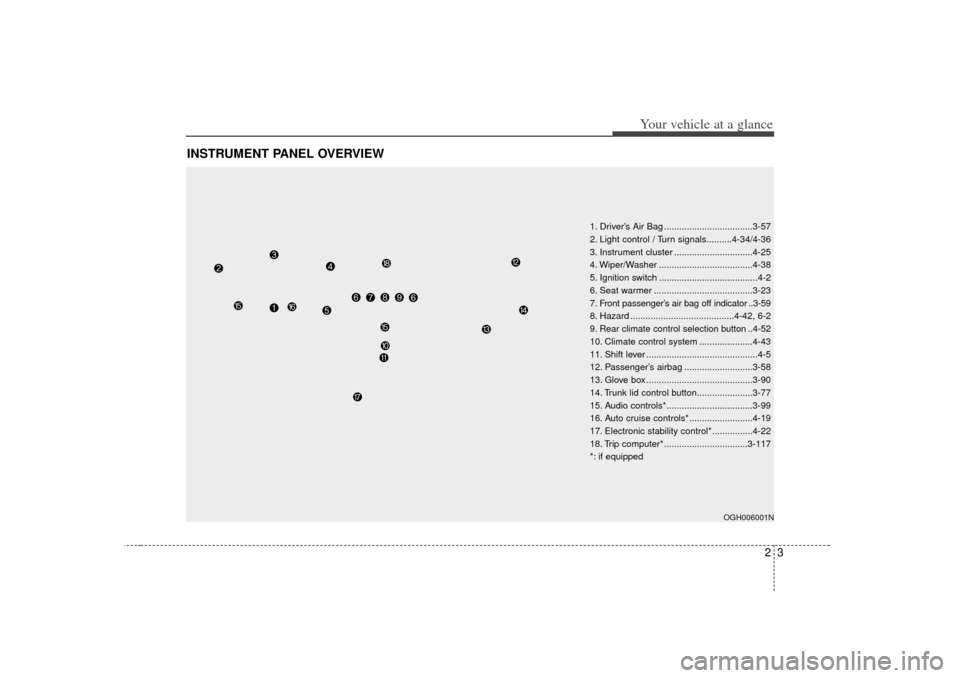
23
Your vehicle at a glance
INSTRUMENT PANEL OVERVIEW
1. Driver’s Air Bag ...................................3-57
2. Light control / Turn signals..........4-34/4-36
3. Instrument cluster ...............................4-25
4. Wiper/Washer .....................................4-38
5. Ignition switch .......................................4-2
6. Seat warmer .......................................3-23
7. Front passenger’s air bag off indicator ..3-59
8. Hazard .........................................4-42, 6-2
9. Rear climate control selection button ..4-52
10. Climate control system .....................4-43
11. Shift lever ............................................4-5
12. Passenger’s airbag ...........................3-58
13. Glove box ..........................................3-90
14. Trunk lid control button......................3-77
15. Audio controls*..................................3-99
16. Auto cruise controls* .........................4-19
17. Electronic stability control*................4-22
18. Trip computer* .................................3-117
*: if equipped
OGH006001N
Page 41 of 283
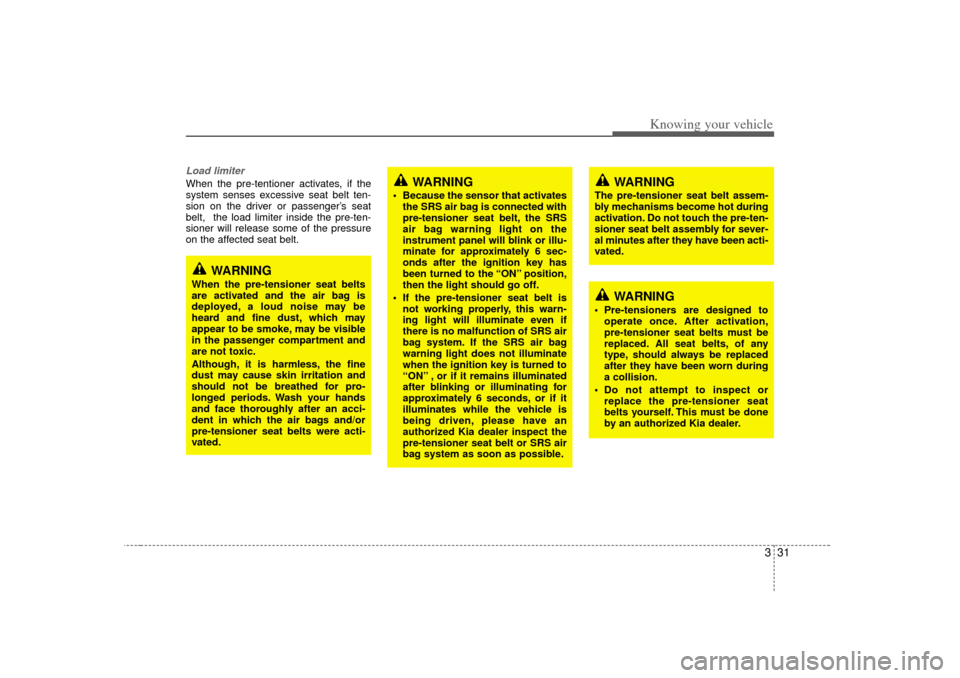
331
Knowing your vehicle
Load limiter When the pre-tentioner activates, if the
system senses excessive seat belt ten-
sion on the driver or passenger’s seat
belt, the load limiter inside the pre-ten-
sioner will release some of the pressure
on the affected seat belt.
WARNING
When the pre-tensioner seat belts
are activated and the air bag is
deployed, a loud noise may be
heard and fine dust, which may
appear to be smoke, may be visible
in the passenger compartment and
are not toxic.
Although, it is harmless, the fine
dust may cause skin irritation and
should not be breathed for pro-
longed periods. Wash your hands
and face thoroughly after an acci-
dent in which the air bags and/or
pre-tensioner seat belts were acti-
vated.
WARNING
Because the sensor that activates the SRS air bag is connected with
pre-tensioner seat belt, the SRS
air bag warning light on the
instrument panel will blink or illu-
minate for approximately 6 sec-
onds after the ignition key has
been turned to the “ON” position,
then the light should go off.
If the pre-tensioner seat belt is not working properly, this warn-
ing light will illuminate even if
there is no malfunction of SRS air
bag system. If the SRS air bag
warning light does not illuminate
when the ignition key is turned to
“ON” , or if it remains illuminated
after blinking or illuminating for
approximately 6 seconds, or if it
illuminates while the vehicle is
being driven, please have an
authorized Kia dealer inspect the
pre-tensioner seat belt or SRS air
bag system as soon as possible.
WARNING
Pre-tensioners are designed tooperate once. After activation,
pre-tensioner seat belts must be
replaced. All seat belts, of any
type, should always be replaced
after they have been worn during
a collision.
Do not attempt to inspect or replace the pre-tensioner seat
belts yourself. This must be done
by an authorized Kia dealer.
WARNING
The pre-tensioner seat belt assem-
bly mechanisms become hot during
activation. Do not touch the pre-ten-
sioner seat belt assembly for sever-
al minutes after they have been acti-
vated.
Page 65 of 283
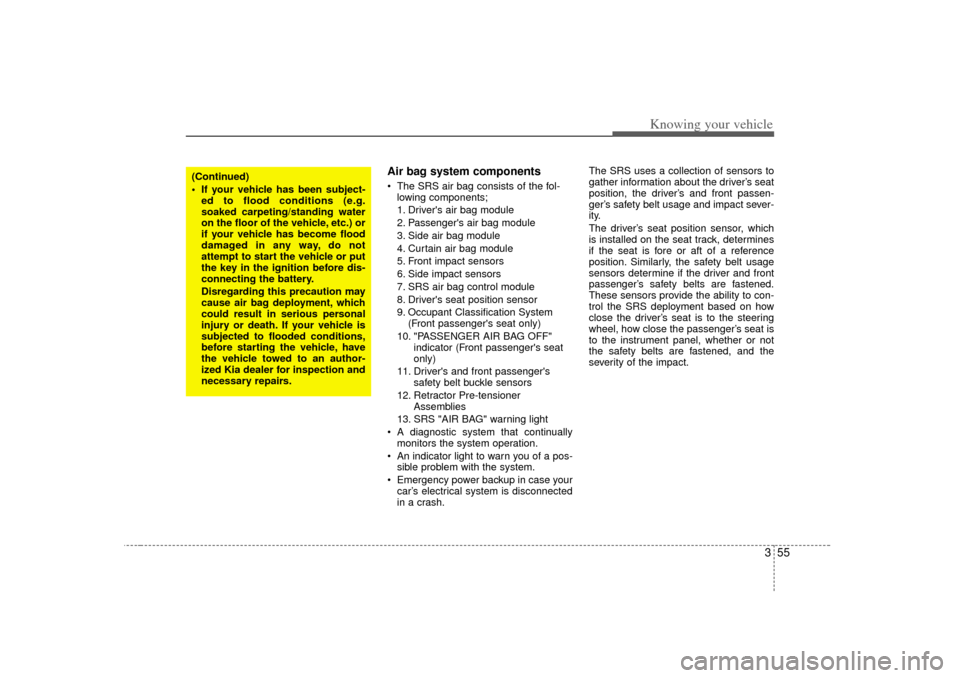
355
Knowing your vehicle
Air bag system components The SRS air bag consists of the fol-
lowing components;
1. Driver's air bag module
2. Passenger's air bag module
3. Side air bag module
4. Curtain air bag module
5. Front impact sensors
6. Side impact sensors
7. SRS air bag control module
8. Driver's seat position sensor
9. Occupant Classification System
(Front passenger's seat only)
10. "PASSENGER AIR BAG OFF" indicator (Front passenger's seat
only)
11. Driver's and front passenger's safety belt buckle sensors
12. Retractor Pre-tensioner Assemblies
13. SRS "AIR BAG" warning light
A diagnostic system that continually
monitors the system operation.
An indicator light to warn you of a pos-
sible problem with the system.
Emergency power backup in case your
car’ s electrical system is disconnected
in a crash. The SRS uses a collection of sensors to
gather information about the driver
’s seat
position, the driver’ s and front passen-
ger’ s safety belt usage and impact sever-
ity.
The driver’ s seat position sensor, which
is installed on the seat track, determines
if the seat is fore or aft of a reference
position. Similarly, the safety belt usage
sensors determine if the driver and front
passenger’ s safety belts are fastened.
These sensors provide the ability to con-
trol the SRS deployment based on how
close the driver’ s seat is to the steering
wheel, how close the passenger’ s seat is
to the instrument panel, whether or not
the safety belts are fastened, and the
severity of the impact.
(Continued)
If your vehicle has been subject- ed to flood conditions (e.g.
soaked carpeting/standing water
on the floor of the vehicle, etc.) or
if your vehicle has become flood
damaged in any way, do not
attempt to start the vehicle or put
the key in the ignition before dis-
connecting the battery.
Disregarding this precaution may
cause air bag deployment, which
could result in serious personal
injury or death. If your vehicle is
subjected to flooded conditions,
before starting the vehicle, have
the vehicle towed to an author-
ized Kia dealer for inspection and
necessary repairs.
Page 68 of 283

Knowing your vehicle58
3Front passenger’s air bagFront passenger’ s air bag is stored in the
instrument panel on the glove box.
Since you cannot know which air bags
will deploy or from what direction, never
put any objects or ornaments on the
instrument panel.
Occupant classification systemThe occupant classification system
detects the presence of a passenger in
the front passenger's seat and will turn off
the front passenger's air bag under cer-
tain conditions.
The occupant classification system is
designed to detect the presence of a
properly-seated occupant and determine
if the front passenger's air bag should be
enabled (may inflate) or not.
Main components of occupant classi- fication system A detection device located within the
front passenger seat cushion.
Electronic system to determine
whether passenger air bag systems
(both front passenger’ s front and side
air bag only) should be activated or
deactivated.
A warning light located on the instru-
ment panel which illuminates the
words "PASSENGER AIR BAG OFF"
passenger air bag system is deactivat-
ed.
The instrument panel air bag warning
light is interconnected with the occu-
pant classification system.
5GHN3001
0GH026257HLZ2121
Page 70 of 283
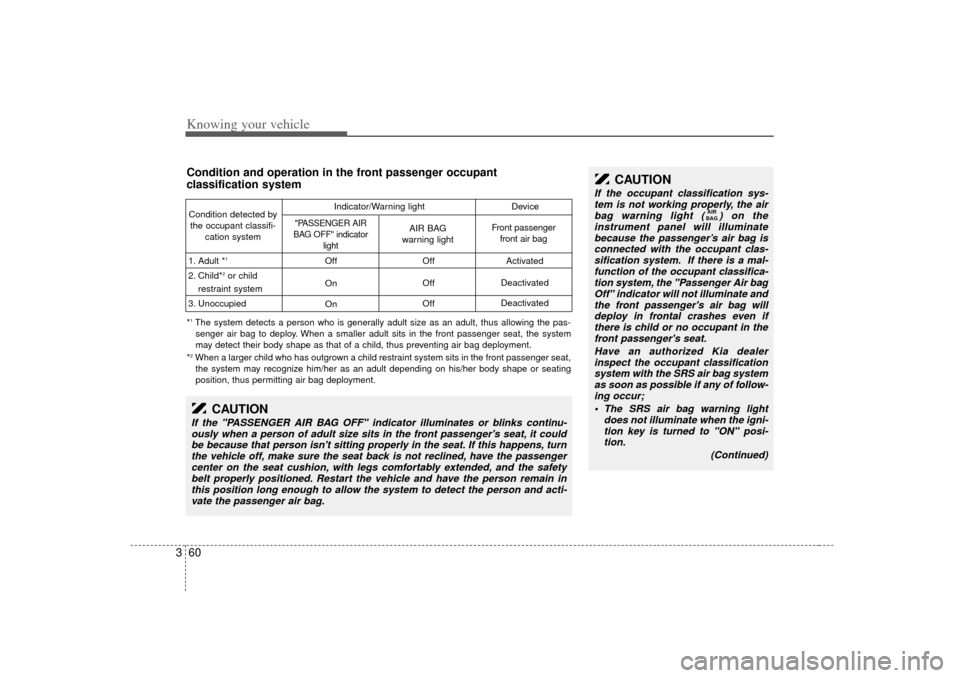
Knowing your vehicle60
3Condition and operation in the front passenger occupant
classification systemCondition detected by
the occupant classifi- cation system
1. Adult *
1
2. Child*
2or child
restraint system
3. Unoccupied Off
On
On Off
Off
Off
Activated
Deactivated
Deactivated
"PASSENGER AIR
BAG OFF" indicator light
AIR BAG
warning light Front passenger
front air bag
Indicator/Warning light
Device
*1The system detects a person who is generally adult size as an adult, thus allowing the pas-
senger air bag to deploy. When a smaller adult sits in the front passenger seat, the system
may detect their body shape as that of a child, thus preventing air bag deployment.
*2When a larger child who has outgrown a child restraint system sits in the front passenger seat, the system may recognize him/her as an adult depending on his/her body shape or seating
position, thus permitting air bag deployment.
CAUTION
If the "PASSENGER AIR BAG OFF" indicator illuminates or blinks continu- ously when a person of adult size sits in the front passenger's seat, it could be because that person isn't sitting properly in the seat. If this happens, turnthe vehicle off, make sure the seat back is not reclined, have the passengercenter on the seat cushion, with legs comfortably extended, and the safetybelt properly positioned. Restart the vehicle and have the person remain in this position long enough to allow the system to detect the person and acti-vate the passenger air bag.
CAUTION
If the occupant classification sys-tem is not working properly, the air bag warning light ( ) on theinstrument panel will illuminate because the passenger’s air bag isconnected with the occupant clas-sification system. If there is a mal- function of the occupant classifica-tion system, the "Passenger Air bag Off" indicator will not illuminate andthe front passenger's air bag will deploy in frontal crashes even ifthere is child or no occupant in the front passenger's seat.
Have an authorized Kia dealerinspect the occupant classification system with the SRS air bag systemas soon as possible if any of follow-ing occur;
The SRS air bag warning light does not illuminate when the igni-tion key is turned to "ON" posi-tion.
(Continued)
AIR
BAG
Page 74 of 283

Knowing your vehicle64
3
Side air bagSide air bags are stored in the left side of
the driver’ s seat, right side of the front
passenger’ s seat and left and right sides
of the rear seats.
Side air bags are designed to deploy only
during certain side impact collisions
depending on the crash severity, angle,
speed and impact. The side air bags are
not designed to deploy in all side impact
situations.
WARNING
Do not use any accessory seat covers for the vehicle equipped
with side air bags.
Use of seat covers could interfere
with side air bag deployment.
If seat or seat cover is damaged,
have the vehicle checked and
repaired by an authorized Kia
dealer. Inform them that your
vehicle is equipped with side air
bags and an occupant detection
system.
Do not make modifications or additions to the seats. If inappro-
priate seats are used, unexpected
injury may result in due to the
malfunction of the air bag sys-
tem.
2GHA2125B
1GHA2126/1GHA2127
(Continued)
Never allow front passenger toput their hands, feet or face on or
close to the instrument panel. In
the event of air bag deployment,
such a mispositioned occupant
would be likely to suffer severe
injury or death.
Never allow children, pregnant women or frail persons to sit in
the front passenger seat. Do not
put child restraint system on the
front passenger's seat either.
They may be seriously injured by
the air bag inflation when air bag
deploys.
Do not put objects or stickers on the instrument panel. Do not
apply any accessory to the front
windshield. Do not install after-
market mirrors or accessories on
the factory-installed rearview mir-
ror. Any of these could interfere
with the deployment of the air bag
or could hit your body at high
speed and cause severe bodily
injury and even death.
Page 82 of 283

Knowing your vehicle72
3
Noise and smokeWhen the air bags inflate, they make a
loud noise and they leave smoke and
powder in the air inside of the vehicle.
This is normal and is a result of the igni-
tion of the air bag inflator. After the air
bag inflates, you may feel substantial dis-
comfort in breathing due to the contact of
your chest to both the safety belt and the
air bag, as well as from breathing the
smoke and powder. We strongly urge
you to open your doors and/or win-
dows as soon as possible after impact
in order to reduce discomfort and pre-
vent prolonged exposure to the
smoke and powder.
Though smoke and powder are non-
toxic, it may cause irritation to the skin
(eyes, nose and throat, etc). If this is the
case, wash and rinse with the cold water
immediately and consult the doctor if the
symptom persists.
WARNING -
Seated
positioning
Driver should sit as far back (at least 250 mm (10 inches)) away
from the steering wheel air bag as
possible to reduce the risk of
injury or death in a collision. The
front passenger should always
move their seat as far back as
possible and sit back in their
seat.
In the event of a collision the air bags inflate instantly. Passengers
may be injured by the air bag
expansion force if they are not in
proper position.
Air bag inflation may cause injuries which normally include
facial or bodily abrasions, injuries
by the broken glasses or burns by
the explosives.
WARNING
When the air bags deploy, the air
bag related parts in steering wheel
and/or instrument panel and/or in
both sides of the roof rails above
the front and rear doors are very
hot. To prevent injury, do not touch
the air bag storage areas internal
components immediately after an
air bag has inflated.
Page 83 of 283
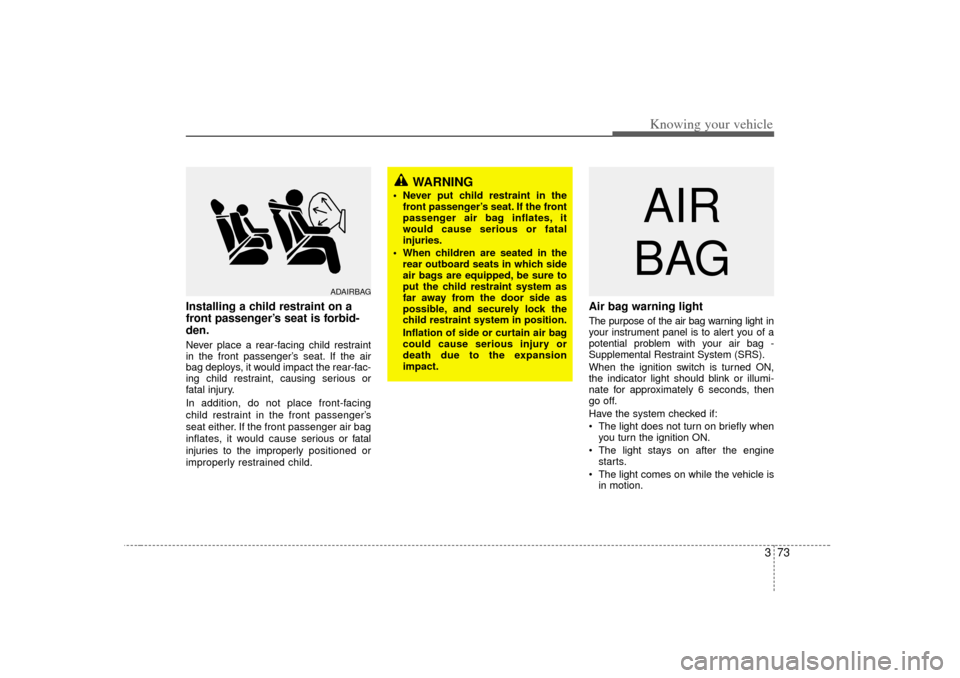
373
Knowing your vehicle
Installing a child restraint on a
front passenger’s seat is forbid-
den.Never place a rear-facing child restraint
in the front passenger’s seat. If the air
bag deploys, it would impact the rear-fac-
ing child restraint, causing serious or
fatal injury.
In addition, do not place front-facing
child restraint in the front passenger ’s
seat either. If the front passenger air bag
inflates, it would cause ser ious or fatal
injuries to the improperly positioned or
improperly restrained child.
Air bag warning lightThe purpose of the air bag warning light in
your instrument panel is to alert you of a
potential problem with your air bag -
Supplemental Restraint System (SRS).
When the ignition switch is turned ON,
the indicator light should blink or illumi-
nate for approximately 6 seconds, then
go off.
Have the system checked if:
The light does not turn on briefly when
you turn the ignition ON.
The light stays on after the engine
starts.
The light comes on while the vehicle is
in motion.
ADAIRBAG
AIR
BAG
WARNING
Never put child restraint in the front passenger’s seat. If the front
passenger air bag inflates, it
would cause serious or fatal
injuries.
When children are seated in the rear outboard seats in which side
air bags are equipped, be sure to
put the child restraint system as
far away from the door side as
possible, and securely lock the
child restraint system in position.
Inflation of side or curtain air bag
could cause serious injury or
death due to the expansion
impact.